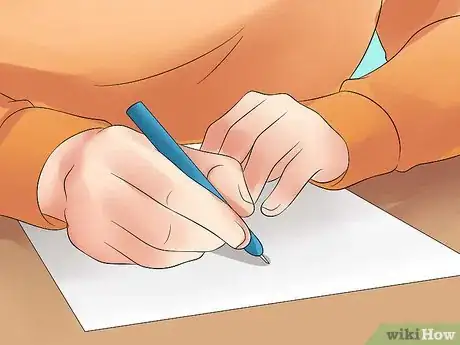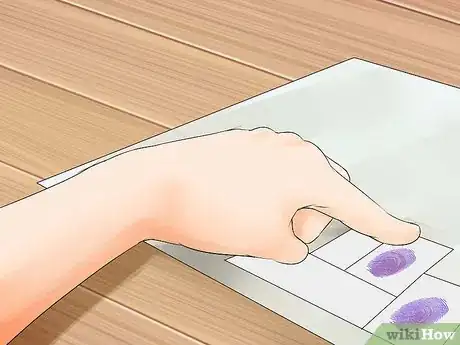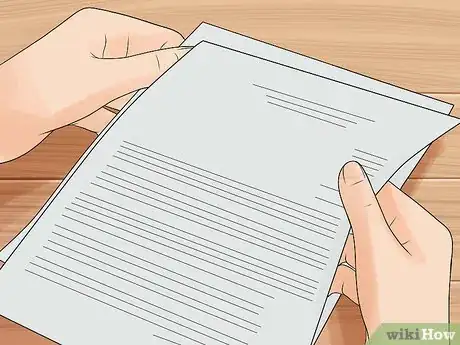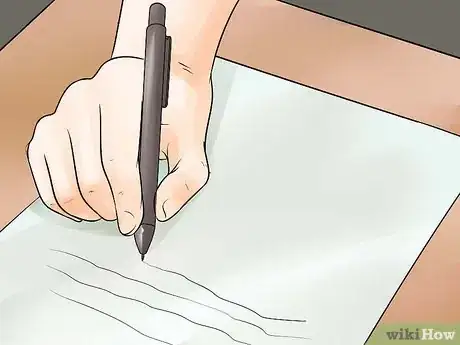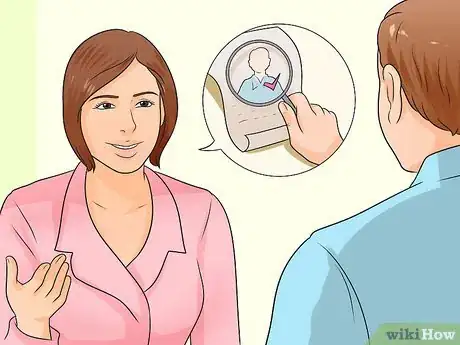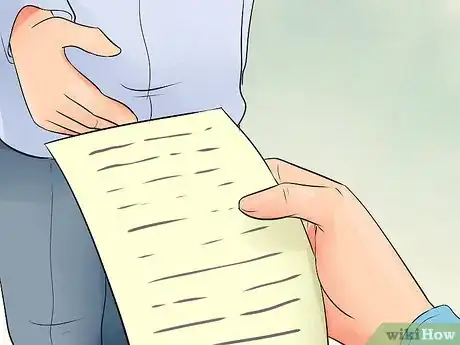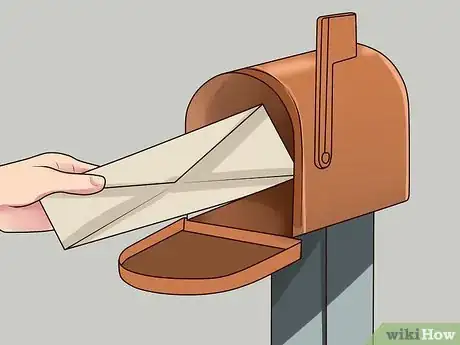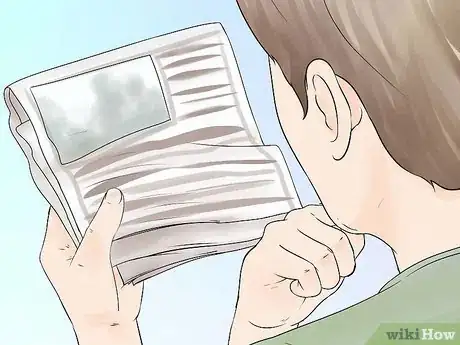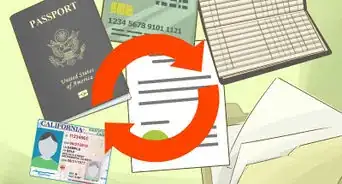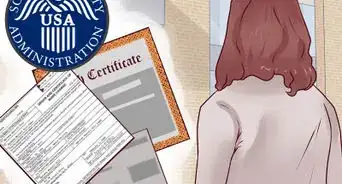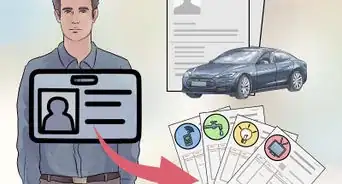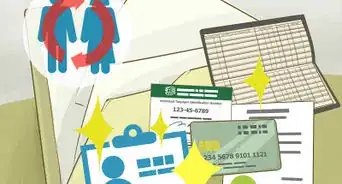This article was co-authored by Clinton M. Sandvick, JD, PhD. Clinton M. Sandvick worked as a civil litigator in California for over 7 years. He received his JD from the University of Wisconsin-Madison in 1998 and his PhD in American History from the University of Oregon in 2013.
There are 9 references cited in this article, which can be found at the bottom of the page.
This article has been viewed 49,297 times.
You may want to change your name following a marriage or divorce, or for unrelated personal reasons. There may also be a time when you wish to change your minor child’s name. In this case, you can file an application with your local court in order to have your name or your child’s name changed by court order.
Steps
Understanding the Requirements for Changing Your Name
-
1Determine if you are eligible to legally change your name. In order to file for a name change through the court system, you must be at least 18 years of age. If you are under the age of 18, your parent, legal guardian, or next-of-kin must file to change your name on your behalf.[1]
-
2Understand that you cannot change your name in order to defraud your creditors or otherwise avoid getting sued or paying your bills.[2]Advertisement
-
3Know that you must be a resident of Minnesota for at least six months before you are able to file a petition to change your name with the court.[3]
Getting an Adult’s Name Changed by Court Order
-
1Fill out the necessary court forms. Be sure to clearly state your current name and the new name. You will need to completely fill out the following forms:[4]
- Application for Name Change Be sure to attach a copy of the legal description for each piece of property owned by you, your spouse, or your minor children, which you can get from the County Recorder or Registrar of Titles for the county in which the property is located.
- Criminal History Check Release
- Proposed Order Granting Name Change Only fill out this form up to the section titled “IT IS ORDERED.”
- If you are an inmate of a correctional institution, you can only file an application for a name change once, unless failing to allow you to do so would infringe on your constitutional rights.
-
2File the forms with the court by mail or by hand-delivery. The forms must be filed with the District Court in your county.
-
3Pay the required filing fee. The total amount of the filing fee is $314.00. Your filing fee is non-refundable. If you cannot afford the filing fee, you can ask the court to waive your filing fee.[5]
- In order to request a Fee Waiver, you must complete the required In Forma Pauperis (IFP) forms. Do not sign the forms. Take or mail them to the District Court in which you live for filing, along with your other name change application forms. The Court Administrator’s Office can notarize your signature on the forms. If the court grants your request, then you will not have to pay the court’s filing fee.
-
4Complete the Criminal History Check. You must submit the Criminal History Check form, a set of fingerprints, and the required fee to the Bureau of Criminal Apprehension in order to have a criminal history check completed. If any applicant for a name change has a criminal record, the person whose name is changed and the court shall report the change within 10 days of receiving the Order Granting Name Change to the Bureau of Criminal Apprehension.[6]
- You report the name change by sending a copy of the order to: Attention: CRIS Section, Bureau of Criminal Apprehension, 1430 Maryland Avenue East, St. Paul, MN 55106.
-
5Give notice of your application to the prosecuting authority, if required. If you have felony conviction under Minnesota law or under the law of any other state or federal jurisdiction, you must give notice of your application to the prosecuting authority who obtained the conviction. If the conviction was from another state or federal jurisdiction, you also must give notice to the Minnesota Attorney General.[7]
- You can send notice to the Minnesota Attorney General at 1400 Bremer Tower, 445 Minnesota Street, St. Paul, MN 55101.
- Send all notices to these authorities using certified mail, return receipt requested. You must file proof of service on the appropriate authorities with the court, which you can do by providing your return receipt to the court at your hearing.
- The prosecutor or attorney general may object to your name change by filing a motion with the court. In this case, the Judge will deny your name change request unless you can prove by clear and convincing evidence that your request is not based on an intent to defraud or mislead, is made in good faith, will not cause injury to a person, and will not compromise public safety. Alternatively, you must prove that the failure to provide the name change as requested would infringe on your constitutional rights.
- Failure to provide the required notices constitutes a gross misdemeanor under Minnesota law if you have a criminal history in Minnesota or any other state.
-
6Receive your court date and time. The Court Administrator’s Office will notify you of your court hearing date and time. You must attend the hearing in person, along with two witnesses who can testify as to your identity.
-
7Receive your Order Granting Name Change. If your application for name change is approved, the judge will sign the Order Granting Name Change. This is the formal document that legally changes your name and that you will use to change your name on your personal records and with other offices. You will need to get certified copies of your Order from the Court Administrator’s Office in order to change your name with other agencies. [8]
- Certified court orders cost $16.00 each, which is $14.00 for the certified copy and a $2.00 technology fee.
Getting a Minor Child’s Name Changed by Court Order
-
1Complete the required court forms. These forms include: [9]
- Application for Name Change of a Minor
- Criminal History Check Release for Name Change of a Minor
- Proposed Order Granting Name Change
- If you want to change the name of your minor child who is aged 14 or older, you must have your minor child sign the Application for Name Change.
-
2Pay the required filing fee. The total amount of the filing fee is $314.00. Your filing fee is non-refundable. If you cannot afford the filing fee, you can ask the court to waive your filing fee.[10]
- In order to request a Fee Waiver, you must complete the required In Forma Pauperis (IFP) forms. Do not sign the forms. Take or mail them to the District Court in which you live for filing, along with your other name change application forms. The Court Administrator’s Office can notarize your signature on the forms. If the court grants your request, then you will not have to pay the court’s filing fee.
-
3Complete the Criminal History Check. You must submit the Criminal History Check form for all applicants over the age of 10, a set of fingerprints for all applicants over the age of 10, and the required fee to the Bureau of Criminal Apprehension in order to have a criminal history check completed. If any applicant for a name change has a criminal record, the person whose name is changed and the court shall report the change within 10 days of receiving the Order Granting Name Change to the Bureau of Criminal Apprehension.[11]
- You report the name change by sending a copy of the order to: Attention: CRIS Section, Bureau of Criminal Apprehension, 1430 Maryland Avenue East, St. Paul, MN 55106.
- Failure to provide the required notices constitutes a gross misdemeanor under Minnesota law if you have a criminal history in Minnesota or any other state.
-
4Give the other parent of your child notice of your Application for Name Change. You must show proof that the other parent has been served with a Notice of Hearing. Contact the Court Administrator’s Office in your county to see if notice by certified mail or by personal delivery is required. If you cannot serve the other parent, you may need to give notice by alternative means.[12]
- If you do not know the identity of your child’s other parent and there is no order of paternity for your child, you must bring a certified copy of the child’s birth certificate to your court hearing.
-
5Personally serve your child’s other parent, if required. You can personally hand the Application to the other parent, or any other person can hand it to the other parent. Complete the Affidavit of Personal Service with the name of the person who served the Application on the other parent. Bring the Affidavit with you to your court hearing as proof that the other parent was personally served.
-
6Send your child’s other parent notice of the court hearing. Once you have received a court hearing date and time from the Court Administrator’s Office, you must send a certified letter to your child’s other parent, return receipt requested, stating the date, time, place, and purpose of the hearing.
- Bring your return receipt showing that you sent notice to the other parent to your court hearing.
-
7Publish notice of the name change application, if required. If you do not know the address of your child’s other parent, you must provide the court with a signed Affidavit in Support of Order for Publication. If the judge orders you to give service by publication, you must arrange to have the Notice of Hearing published in a newspaper located in the county in which the other parent resides. You are responsible for paying the costs of publication to the newspaper.[13]
- The notice must be published once a week for three consecutive weeks.
- Payment will differ from one newspaper to the next. Contact the newspaper in the appropriate county for information about the required payment.
- Once the Notice has been published, the newspaper will provide you with an Affidavit of Publication, which you must file with the Court prior to your scheduled hearing date.
- Your court hearing cannot occur less than 10 days after the last publication date.
-
8Bring your minor child to the court hearing. If the Court approves your Application, the judge will sign the Order Granting Name Change. This is the legal document that you will use to change your child’s name elsewhere.
Changing Your Name After You Receive a Court Order
-
1Notify other offices of your change of name. Using your name change decree, you must notify all institutions and establishments with which you do business. This would include the IRS, the Social Security Administration, banks, and all of your creditors or offices where you have accounts.[14]
-
2Notify the Minnesota Department of Public Safety – Driver & Vehicle Services of your name change. You will need a certified copy of your name change order in order to change your name with this agency. This will allow you to obtain an identification card or driver’s license that shows your new name.[15]
-
3File a certified copy of your Order Granting Name Change with the County Recorder, if required. If you are granted a name change, you must file a certified copy of your Order with the County Recorder of each county in which you, your spouse, or your minor child own real estate.[16]
-
4Understand that in most situations, your birth certificate will not be changed to reflect your new name. There are only exceptional circumstances under Minnesota law in which a birth certificate should be changed to show your new name. Because this situation is so unusual, you should seek legal advice if you want your birth certificate to be changed.[17]
- If there is a mistake on your birth certificate or it is otherwise wrong, you can try to correct the error by contacting your local County Vital Statistics Office or the Minnesota Department of Health.[18]
Warnings
- Court records are open to the public, so the fact that your name has changed is public knowledge, unless the court has determined that your name has been changed in connection with a victim or witness protection program.⧼thumbs_response⧽
References
- ↑ http://www.mncourts.gov/Help-Topics/Name-Change.aspx
- ↑ http://www.mncourts.gov/Help-Topics/Name-Change.aspx
- ↑ http://www.mncourts.gov/Help-Topics/Name-Change.aspx
- ↑ http://www.mncourts.gov/Help-Topics/Name-Change.aspx
- ↑ http://www.mncourts.gov/Help-Topics/Fee-Waiver-IFP.aspx
- ↑ http://www.mncourts.gov/mncourtsgov/media/CourtForms/NAM101.pdf?ext=.pdf
- ↑ http://www.mncourts.gov/mncourtsgov/media/CourtForms/NAM101.pdf?ext=.pdf
- ↑ http://www.mncourts.gov/mncourtsgov/media/CourtForms/NAM101.pdf?ext=.pdf
- ↑ http://www.mncourts.gov/GetForms.aspx?c=27&p=86
- ↑ http://www.mncourts.gov/Help-Topics/Fee-Waiver-IFP.aspx
- ↑ http://www.mncourts.gov/mncourtsgov/media/CourtForms/NAM203.pdf?ext=.pdf
- ↑ http://www.mncourts.gov/Help-Topics/Name-Change.aspx
- ↑ http://www.mncourts.gov/mncourtsgov/media/CourtForms/NAM206.pdf?ext=.pdf
- ↑ http://www.mncourts.gov/mncourtsgov/media/CourtForms/NAM106.pdf?ext=.pdf
- ↑ http://www.mncourts.gov/Help-Topics/Name-Change.aspx
- ↑ http://www.mncourts.gov/Help-Topics/Name-Change.aspx
- ↑ http://www.mncourts.gov/Help-Topics/Name-Change.aspx
- ↑ http://www.health.state.mn.us/divs/chs/osr/amend.html
About This Article
In order to change your name in Minnesota, you must be at least 18 years old and have lived there for 6 months. If you qualify, go online and download the required forms. Figure out where your county’s District Court is located, and submit the completed application and proposed order with the $314 filing fee there. You’ll also need to fill out a criminal history check release. Send that, with fingerprints and the fee, to the Bureau of Criminal Apprehension. When you get your court date, take two people you know as witnesses. To learn more from our Civil Litigator co-author, like how to change the name of a minor in Minnesota, keep reading the article!



